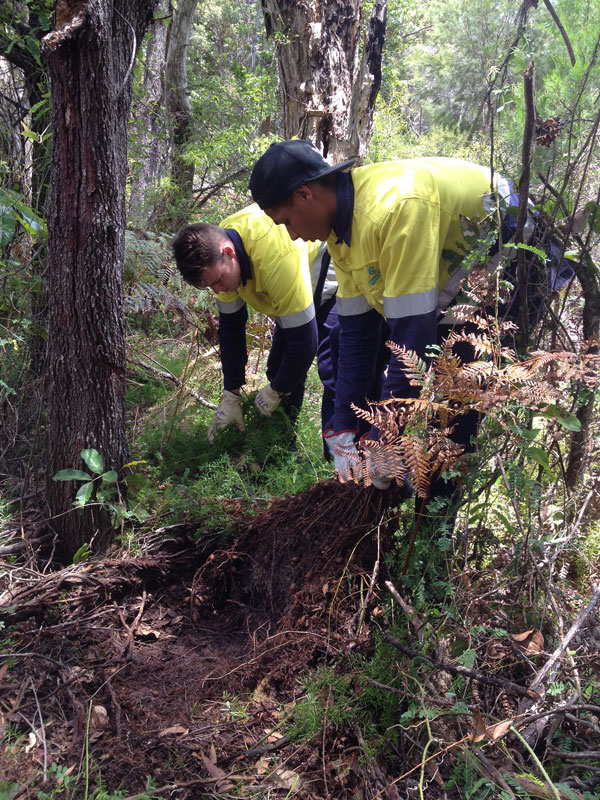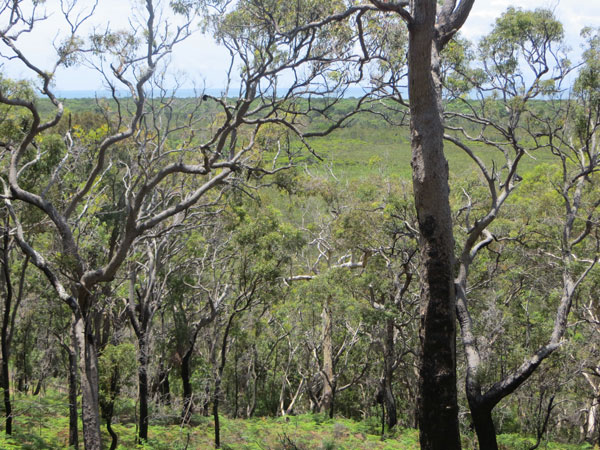Header: Celebrating this historic Land for Wildlife registration are (left to right):
Lordie Walker, QCR; Richard Martin, QCR; Cr Craig Ogilvie; Maree Manby, RCC; Phil Sutherland, Biosecurity Queensland; Joel Bolzenius, SEQC; Kurun Ruska, QCR; Cameron Costello, QYAC CEO; William Smart, QCR and Darren Burns, QYAC.
In June 2015, Quandamooka Yoolooburrabee Aboriginal Corporation (QYAC) registered almost 1,400 hectares of significant bushland on Minjerribah (North Stradbroke Island) with the Land for Wildlife program. This is now the largest Land for Wildlife property managed by Traditional Owners in Queensland. The land registered with Land for Wildlife only includes land on which the Quandamooka People have been recognised as having exclusive native title rights, granting them the exclusive rights to possess, occupy, use and enjoy these lands. Redland City Council (RCC) and the Land for Wildlife program are privileged to partner with QYAC for this historic Land for Wildlife registration.
The registration demonstrates Quandamooka People’s leadership and commitment to land and sea management. The registered land contains high ecological and cultural values and some of the grand old trees would be classed as the oldest veteran or heritage trees known to exist in Redland City. These lands are also home to threatened flora and fauna including the Yellow Swamp-orchid (Phaius bernaysii) and Oxleyan Pygmy Perch (Nannoperca oxleyana).
Minjerribah also contains a unique population of healthy Koalas. Research indicates that Minjerribah Koalas are genetically distinct from mainland Koalas, as the Koalas on Minjerribah descended from a population that was isolated on the island about 8,000 years ago after the last sea level rise. Minjerribah Koalas are largely disease free, or at least do not exhibit signs of common Koala diseases found on the mainland. Interestingly, the most closely related Koalas are those found on the Gold Coast. Research also shows that Koalas on Minjerribah are likely to be the only naturally-occurring island Koalas in Australia.
Quandamooka People have been caring for country for over 40,000 years. More recently, QYAC has established the Quandamooka Community Rangers (QCR), which has seen young Quandamooka People develop skills to manage weeds, control pest animals, protect cultural artefacts and restore country. Key weeds include Basket Asparagus Fern, Camphor Laurel, Umbrella Tree and Moth Vine.
QYAC is a key agency in the Straddie Pest Management Group that is working towards eradication of foxes from Minjerribah. QYAC is also a key partner in the North Stradbroke Island Fire Management Group. These groups offer opportunities for agencies to collaboratively work together.
“Quandamooka People have been caring for country for over 40,000 year”
The types of vegetation registered with Land for Wildlife, and currently being managed by QYAC, include mangrove shrubland, heathland, coastal dunes, wetlands and woodlands and includes nationally significant Threatened Ecological Communities such as Salt Marsh and Littoral Rainforest.


(Left:) Quandamooka Community Rangers, Jai Adley (left) and Jarlon Burns (right), removing Basket (Ground) Asparagus, a declared Weed of National Signi cance, near Amity Point. Photo by Deborah Metters.
(Above:) Looking out over Quandamooka country towards Flinders Beach. Photo by Maree Manby.
In mid-2015, QYAC and SEQ Catchments entered into a Memorandum of Understanding as a way of formally recognising collaborations between the organisations and acknowledging Quandamooka People as being at the forefront of natural resource management on Quandamooka Country. This Land for Wildlife registration creates the platform for further partnerships between QYAC, Redland City Council and SEQ Catchments. Already the three organisations are working towards an open day in 2016 whereby other Land for Wildlife members will be invited to come and experience Quandamooka Country and Quandamooka land management first hand.
This registration provides a valuable opportunity for QYAC to showcase traditional owner values, land management and cultural heritage to the broader Land for Wildlife network whilst increasing opportunities to work with Redland City Council and SEQ Catchments in managing Minjerribah’s iconic landscapes.
References & Further Reading
Lee KE, Seddon JM, Corley SW, Ellis WAH, Johnston SD, de Villiers DL, Preece HJ & Carrick FN (2009) Genetic variation and structuring in the threatened koala populations of Southeast Queensland. Conservation Genetics 11, 2091-2103.
Stephens K & Sharp D (2009) The Flora of North Stradbroke Island. Qld Environmental Protection Agency
Dreaming On The Movie
